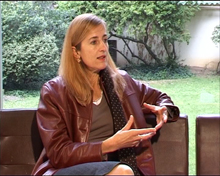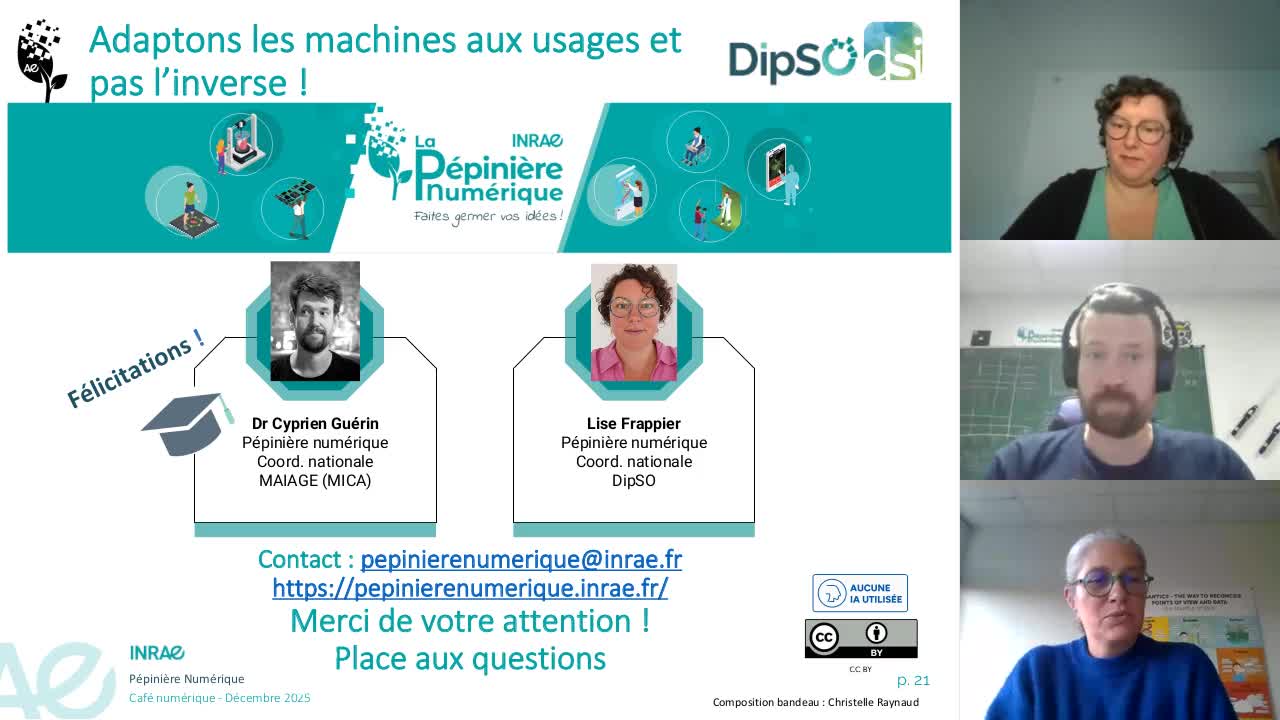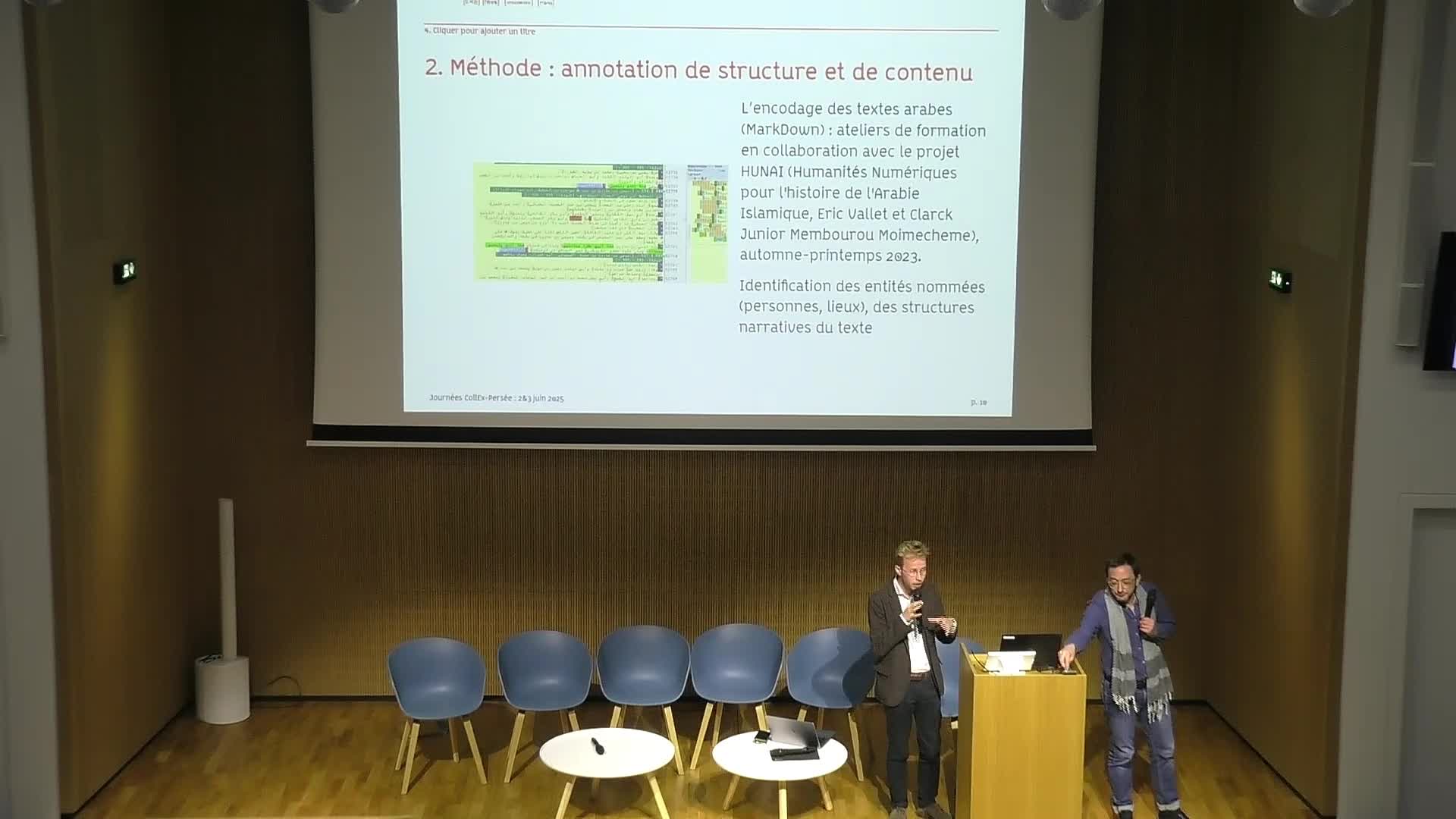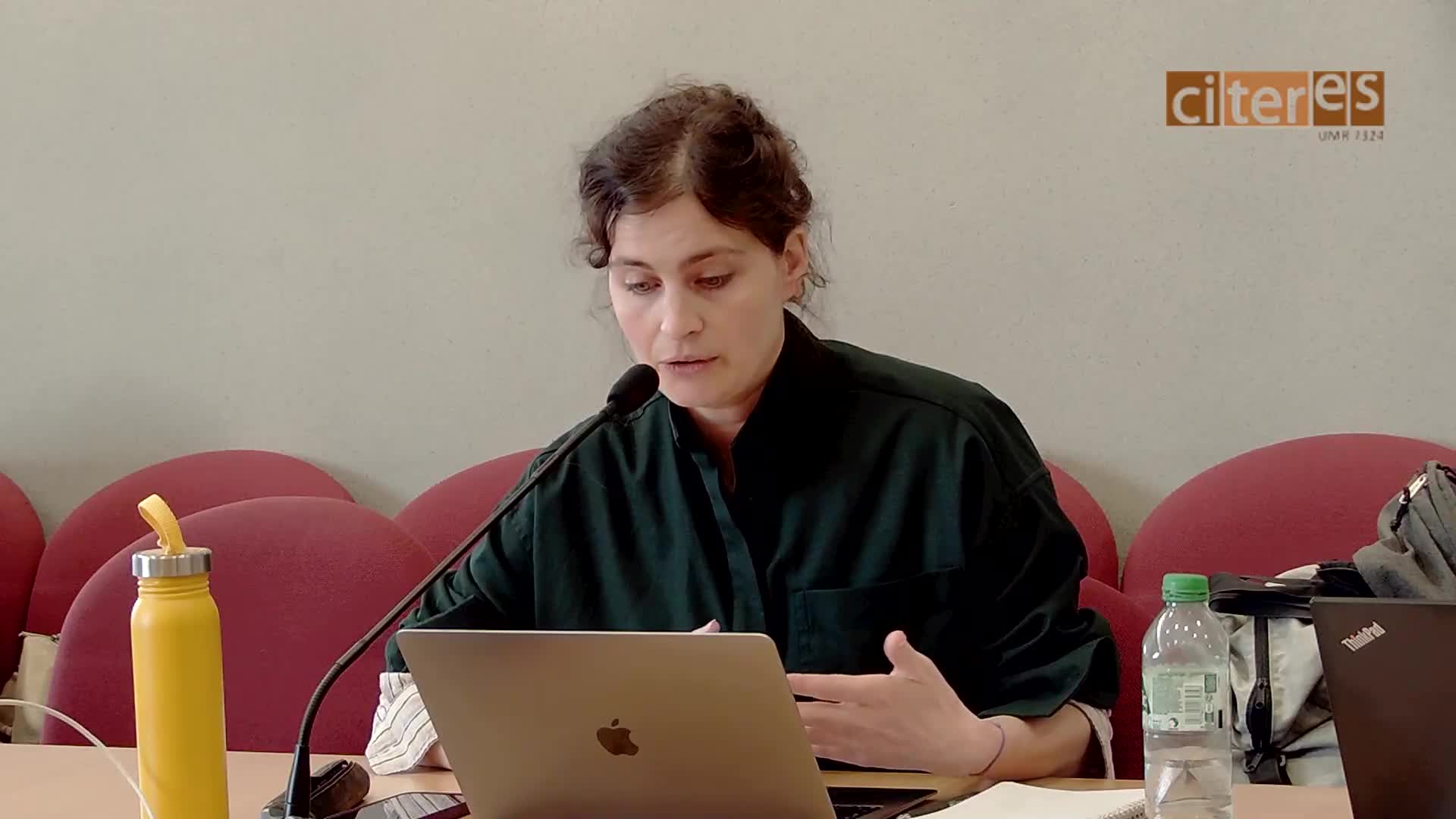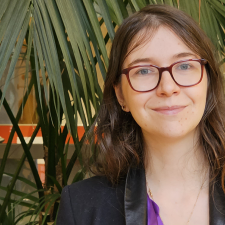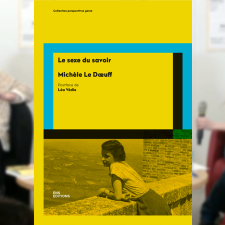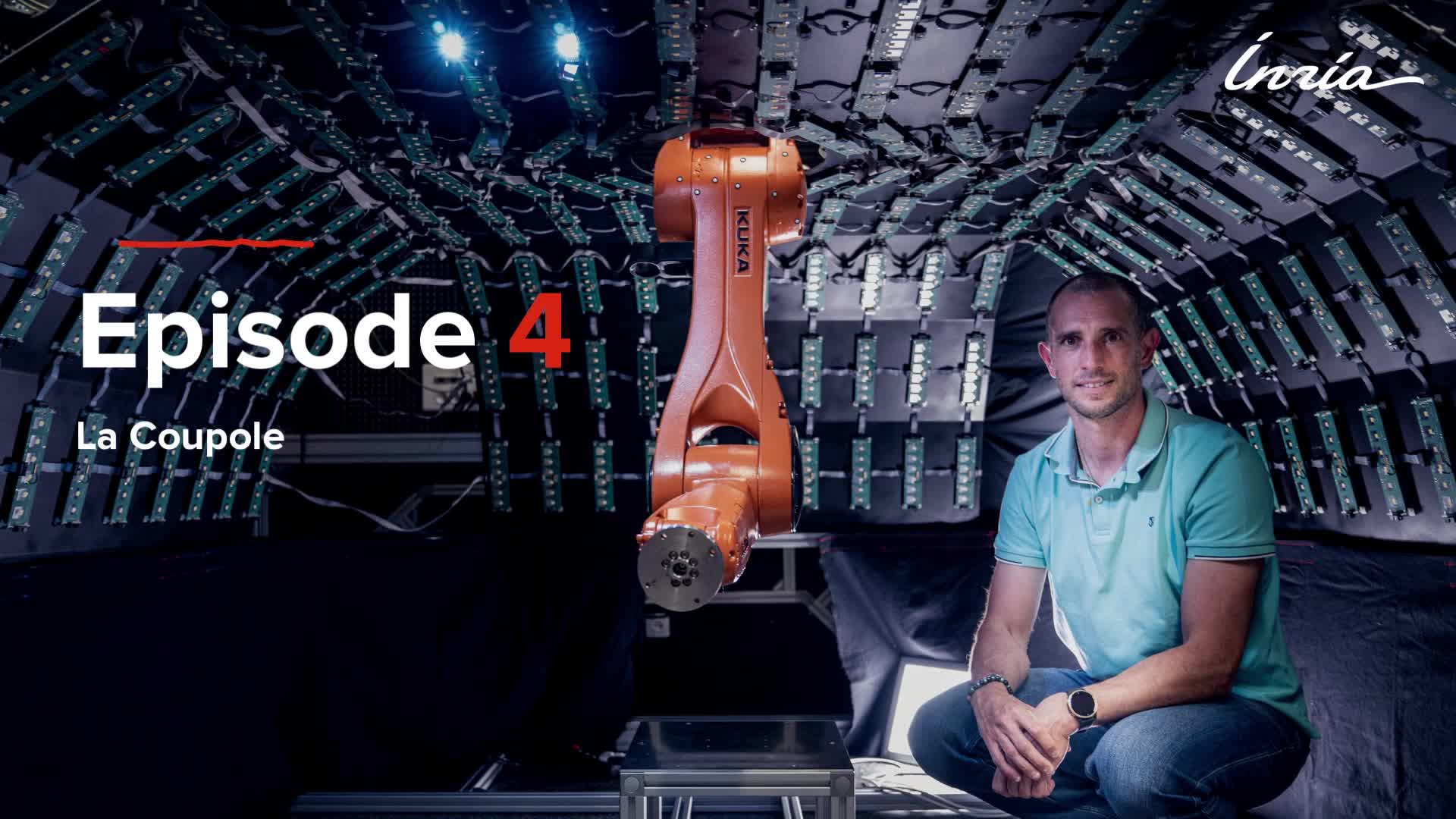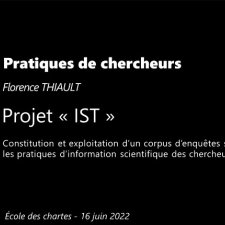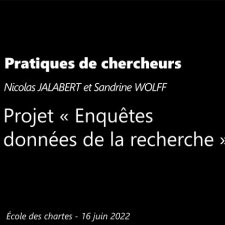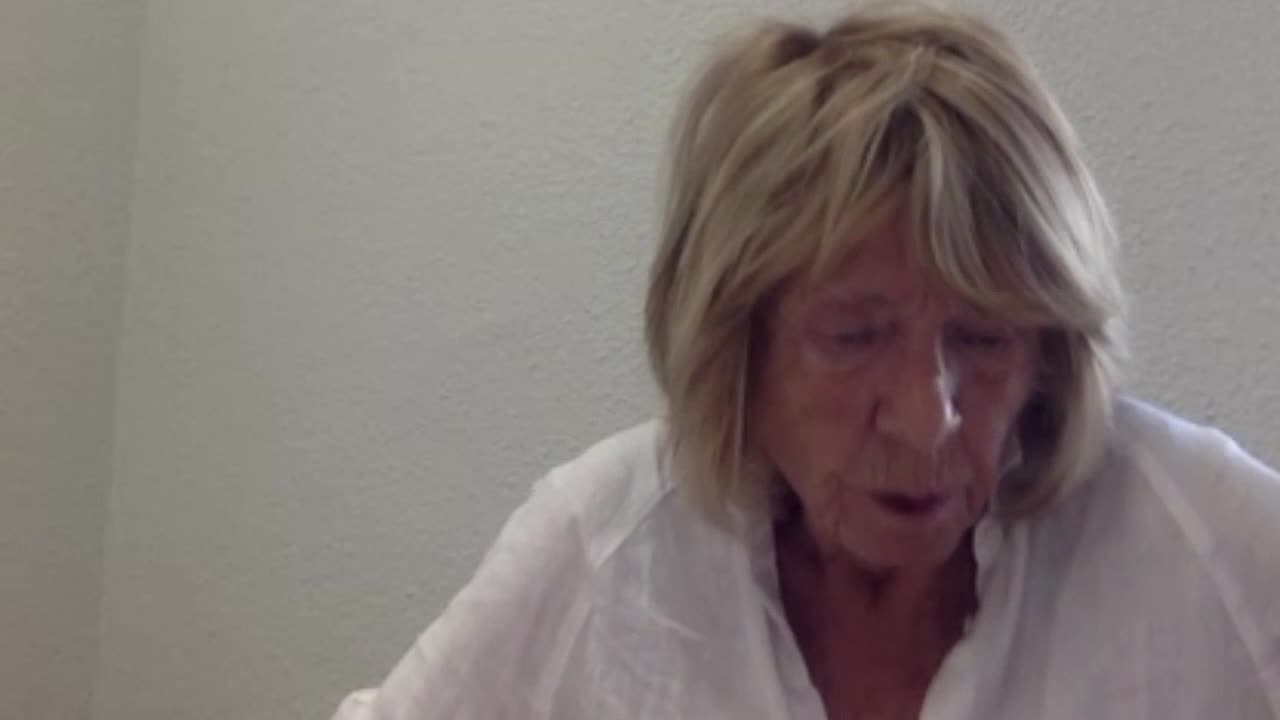Chapitres
- Présentation05'50"
- Rencontre avec Jean Rouch06'42"
- Préparation du terrain04'28"
- Départ pour le terrain08'36"
- Apprentissage de la langue otjiherero11'16"
- Relation anthropologue/communauté14'58"
- Station de recherche : un rêve devenu cauchemar07'43"
- Retour au village06'02"
- Méthodologie du traitement des données03'46"
- Etude des pratiques musicales et de transe04'54"
- Cérémonie des esprits05'04"
- Le maître de cérémonie03'04"
- Prise de possession03'52"
- Musique pour l'appel des esprits04'15"
- Histoires de mauvais sort06'35"
- Les instruments de musique ovahimba08'36"
- Les chants ovahimba04'45"
Notice
Sept années chez les Ovahimba
- document 1 document 2 document 3
- niveau 1 niveau 2 niveau 3
Descriptif
Rina SHERMAN revient dans cet entretien sur son expérience de terrain chez les Ovahimba avec qui elle a passé de nombreuses années. Elle nous explique la complexité des relations avec les Ovahimba, son rapport avec la langue locale, son approche en anthropologie visuelle et nous parle également des pratiques musicales de ce peuple.
>> Pour en savoir plus sur Rina Sherman et sur ses travaux, consultez le site : http://www.rinasherman.com/
Rina SHERMAN, née en Afrique du Sud, s'est exilée et installée en France où elle habite et travaille depuis 1984. Musicienne de formation, elle a validé un doctorat sous la direction de Jean Rouch à la Sorbonne. Elle a écrit plusieurs livres, le premier étant Uitreis publié en Afrique du Sud en 1997. En plus d'être écrivain elle est également cinéaste, photographe et anthropologue.
Intervention / Responsable scientifique
Thème
Documentation
Filmographie,Galerie Photos,Bibliographie,Curriculum Vitæ
Anthropologue, le retour
An anthropologist's vision of Paris after seven years in the field in Africa.
Work in Progress
Keep the Dance Alive / que la danse continue
A film about the music dance and spirit possession practices of the Ojtiherero language-speaking groups of north-western Namibia and south-western Angola. They are the Ovahimba, Ovadhimba, Ovahakaona, Ovakuvale, Ovatjimba... They are different but share a common culture and belief systems. The film explores the various ways in which music and dance transcend their everyday lives from infancy to death. For more information. Order
Un film sur des pratiques de musique, de danse et de transe de possession des groupes de langue Otjiherero du nord-ouest namibien et du sud-ouest angolais. Ils sont Ovahimba, Ovadhimba, Ovahakaona, Ovagambwe, Ovakuvale, Ovatua. Ils partagent tous une même culture et un même système de pensée. Le film explore les différentes façons dont la musique et la danse transcendent leur vie quotidienne de la petite enfance jusqu'à la mort. Pour plus d'informations. Commander
Production : Art Cinématographique Artisanal / Low Tech Film Art. 120 mn, video, 2006.
Ovaryange tji veya / When Visitors Come / Quand les invités arrivent
A film about the relationship between anthropologist, Rina Sherman and an Omuhimba family with whom she lived for seven years, filming and photographing aspects of their everyday and ritual lives. Halfway through her tenure in the field, Rina Sherman presented a multi-media exhibition, entitled The Ovahimba Years: Work in Progress in Windhoek, the capital of Namibia. A group of young people from the community of Etanga travelled to Windhoek to participate in the exhibition.
The film explores the evolution of this relationship that lead to the exhibition, shows the group of young people discovering the presentation of their cultural heritage at the exhibition, holding performances as part of the programme presented, and shows the resulting discussions and consequences of the exhibition, once everyone is back in Ovahimba country. When Visitors Come is a film about an anthropologist in situ, and evokes several notions central to fieldwork, such as the nature of the bond between the observer and the observed, the observed observer, participant-anthropology and emotion as possible vector or hindrance in fieldwork. 30 mn, video, 2006.
Production : Art Cinématographique Artisanal / Low Tech Film Art. Extracts Here and Here.
Buy / Acheter.
Kurakurisa Ouruvi / Shake Your Brains
A film about the relationship between anthropologist, Rina Sherman and an Omuhimba family with whom she lived for seven years, filming and photographing aspects of their everyday and ritual lives. Halfway through her tenure in the field, Rina Sherman presented a multi-media exhibition, entitled The Ovahimba Years: Work in Progress in Windhoek, the capital of Namibia. A group of young people from the community of Etanga travelled to Windhoek to participate in the exhibition.
The film explores the evolution of this relationship that lead to the exhibition, shows the group of young people discovering the presentation of their cultural heritage at the exhibition, holding performances as part of the programme presented, and shows the resulting discussions and consequences of the exhibition, once everyone is back in Ovahimba country. When Visitors Come is a film about an anthropologist in situ, and evokes several notions central to fieldwork, such as the nature of the bond between the observer and the observed, the observed observer, participant-anthropology and emotion as possible vector or hindrance in fieldwork. Video, 50 mn, 2000.
Production : Art Cinématographique Artisanal / Low Tech Film Art. Order DVD
Screenings: Première: 2002, National Theatre of Namibia.
Avril 2004: Cinéma et anthropologie filmique, Chroniques d'un autre regard, Cinémathèque française,
Festival Selection: October 2000, 21st Durban International Film Festival. More and Photograph.
Buy / Acheter
Antropologiavisiva
Voyage, Voyage - La Namibie
In the Outskirts of Opuwo, the country of the Ovahimba and Ovaherero pastoral peoples. Impressions of a sojourn in this northern frontier town, a melting pot in its own right. Video, 40 mn, 1999.
Production: JBA Productions for the series, VOYAGE, VOYAGE of LA SEPT ARTE, Order from: Arte VOD
Screenings:
April 1999, First Notes from the Field, National Gallery of Namibia.
Avril 2004, Cinéma et anthropologie filmique, Chroniques d'un autre regard, Cinémathèque française.
Arte Documentaires Fiche Programme
Namibie La Sept / ARTE
La médiathèque
Arte VOD / Buy the film - Arte / Acheter le film - Arte
Southern African Urban Dance Collection N° 1
Video, 72mn, 1996.
First Steps: The Children of Renco Mine At the school of the Rio Tinto Gold Mine near Masvingo in Zimbabwe, children are taught dance as part of their school curriculum. Their bodies are totally engaged with the boys playing percussion whilst the girls take their first dance steps.
Pas de deux, pas de trois : Bulawayo Dancing In true Matabele tradition, the harmonising voices of a group of dancers singing a cappella rise from the veranda of a clinic as accompaniment to their dance steps that are reminiscent of Broadway in the thirties...
Un entrée digne : Isicathamiya in Durban Under the auspices of SATMA, all night Zulu men's choir competitions are organised by Paul every Saturday evening in Durban. The a cappella voices of the men rise into singing marked by furtive isteps, which is followed by a Best Dressed Man Competition where the men display their latest styles...
Mtshongolo : The Shangaan of Kagiso In Kagiso, a township west of Johannesburg, the Krugersdorp Stars, TK Swinyeleteni, partake in competitions every Sunday. The Shangaan rites of passage from birth to the age of adulthood are re-enacted over and again.
Production : Art Cinématographique Artisanal
Festival Selection: Vidéo Danse, Centre Pompidou, 1996.
This is my Regular Album
Sous le pont... An American boat passes under the Alexandre III bridge with the Eiffel tour in the background.
Sur la voie express. Cars rush by as an American boat follows its course.
Derrière la bibliothèque. Besides the building site of the Grand Bibliothèque in Paris, a train arrives.
Depuis le balcon. At 1 am the lights on the Eiffel tour are turned off.Four one-minute films for the project, «Lumière 2000» of the GREC. 16 mm 4 mn, 1996.
Selection : SRF, Short Film Day, Cannes Film Festival, 1996.
Walahi-Wo!
A concert film of Hugh Masakela and a company of South African musicians, including Dolly Rathebe, Dorothy Masuku, Mara Louw, Mbusi Mhlongo, Jonas Gwangwa, Bayete, The Elite Swingsters, etc. Concert held as part of the exhibition, Afrique du sud : Musiques de liberté, La Villette, Paris, 1995. Video BetaSP, 2h15, 1995/7.
Production : Art Cinématographique Artisanal
M. M. les locataires
In Noisy-le-Sec, a city-suburb in the North-East of Paris, the city forms a human landscape, painted from one encounter to the next. The characters participate in the invention of a story exploring past, present and future in parallel. In close contact with a handheld camera, they tell the stories of their lives and improvise a tale that is both authentic and imaginary. The urban images chosen as decor are complimented by a sound universe alternating between invented and live sounds. 16 mm, 64 mn, 1995.
Production : Art Cinématographique Artisanal
Selected: Cinéma Nouveau de Pesaro, Italy.
Texts about the film: Click here
Bantu Education
A South African dress designer Meisie Mosimane comes to Paris to have clothes made up in the Goutte d'or neighbourhood of Paris. An intimate view of a certain Paris. S8 mm/video BetaSP, 30 mn,1994.
Production : Art Cinématographique Artisanal
Selected: 9th Festival du Film les traditions du Monde, Saintes
An Egg with no Shell / L'œuf sans coquille
A male diva sings in a counter-tenor voice whilst massacring chickens of all kinds brought to him by his butler, Jean Rouch. Until a slave provides proof of his love for the chicken, which he has tucked under his arm. A film-opera based on a poem and a theme composed by the director. 35 mm, 13 mn, 1992.
Production : Art Cinématographique Artisanal
Selected: Festivals of Grenoble. Prades, Roanne, France. Uppsala, Sweden. Weekly Mail, Johannesburg.
eKhaya retrouvée, pays d'ombres / eKhaya Revisited, Land of Shadows
Return visit to South Africa after seven years of exile, filmed in the first person. The family and South Africans of different cultural origins evoke the possible future of a single nation. Video Hi-8/16 mm, 52 mn, 1990-2
Production : Art Cinématographique Artisanal
Selected: Etats Généraux du Film Documentaire, Lussas. Bilan du Film Ethnographique, Paris. Vues d'Afrique, Montréal. Dei Popoli, Florence, Riminicinema, Italie. Broadcast on Planète Cable, 1993.
Entrée et sortie avec Suzanne / Entrance and Exit with Suzanne
A day in the life of a nursery nurse in the Lilas Clinic near Paris. Suzanne has developed a special massage technique for the newly born. S8 mm, 15 mn, 1984.
Production: VARAN
Chicken Movie. Cluck!
A chauffeur drives his Madam about in downtown Johannesburg; visits to friends, townships, wastelands. The trip ends with a nuptial-funeral ball where the men dance to the cock's crow and the rhythm of Zulu music. 16 mm, 20 mn, 1984.
Production : Art Cinématographique Artisanal
Selected: Festival Films de Femmes, Créteil.
Talking Heads
Interviews with the intelligentsia of Johannesburg expressing themselves in favour of a multimedia art space for the performance art group, Possession Arts. Video U-matic, 60 mn, 1983 (Film lost ?).
Antics of the Artists / Bouffoneries des artistes
In and around the pool an array of creatures move about. A scene of the famous novel Seven Days at the Silbersteins by Etienne Leroux to the music of Peter Klatzow, Still-life with Moonbeams. 16 mm, 7 mn, 1983.
Production : Art Cinématographique Artisanal
Eugene Jardin
Portrait of a South African born sculptor, living on the US West coast, filmed during a return visit to Johannesburg for an exhibition of a series of portraits of Woody Allen, Jody Foster and the likes...16 mm, 7 mn, 1983.
Production : Art Cinématographique Artisanal.
,
© Rina Sherman. All Rights Reserved.
The user agrees to respect intellectual property rules as defined in french legislation.
|
|
© Rina Sherman. All Rights Reserved.
The user agrees to respect intellectual property rules as defined in french legislation.,When Elsewhere Becomes The Here and Now: Seven Years of Fieldwork with the Ovahimba,
Les années Ovahimba, The World Turns Like the Horns of a Kudu: From the Self to the Other and Back, The Ovahimba Years Work in Progress,
in AnthropoPages no. 5-6, March 2006, Terrains vécues : Terrains revécues, Edition Ici et Ailleurs - GRAEA (Groupe de recherches et d'actions en ethnologie et en anthropologie).
Le film africain & Le film du sud, novembre 2002, no. 41, pp 45-56. See Cover
Die Republikein, 2002, translated from the Afrikaans. Read
Exhibition catalogue, published by ACA/LTFA, 2002, ISBN: 999 16-50-94-6. See Cover. Read Texts.
,
Professional activities
1997-06
Development and implementation of the project, The Ovahimba Years, a multi-disciplinary research programme involving anthropology, cinematography and oral literary traditions. Currently processing seven years of data collection (film, video, photography, texts) in the field.
1998
Brouillon d'un rêve bursary (SCAM, Société Civile d'auteurs Multi-média) for the film project: Du côté de Stains, projet modified to: Anthropologue, le retour.
Lavoisier Bursary awarded by the French Ministry of Foreign Affairs) for the multi-disciplinary project: The Ovahimba Years.
1997
Publication of Uitreis (En partance) , first novel.
Villa Medicis Hors les Murs Prize for: The Southern African Film Archive Project
1996
Jean Rouch, Southern African University Tour. Curator and project director.
1995
La Villette : Afrique du Sud - Musique de Libertés, Audio-visual Director: Creation of an audio-visual promenade, including an archive film, Welcome- Bienvenue
Curator : Retrospective of 50 years of South African cinema.
Director / Co-producer of a concert-film of Hugh Masakela, Dolly Rathebe, Dorothy Masuku, Mara Louw and a company of South African musicians.
ZDF, Formation Films, London. Production manager: Rouch in Reverse by Manthia Diawara
1992
FR3, BBC, NFI (Netherlands Film Institute): Madame l'eau by Jean Rouch. Post-production manager.
1992-91
Ima Productions : Feature film development - USA.
1990-89
Cobblestone Films, NY: Alexandre Trauner et la decoration au cinéma,1st Assistant Director.
1984-82
South African Broadcasting Coorporation, Vision mixer: Drama & music productions
Graduate Studies
1990-86
Ph. D. Université de la Sorbonne, Paris I & X. Research Supervisor: Jean Rouch.
UnderGraduate Studies
1982
Bachelor of Music (Hons.). University of the Witwatersrand
1980
Licentiate of Music, Trinity College of Music, S.A.
1981-77
Various Undergraduate studies: German, History of Art, Psychology, Anthropology.
Professional Development
1995-03
Course: Filming in 16 mm, FTIS
1992
Screen writing Workshop, Cinémathèque Française.
1991
Story Structure Course, Robert McKee, London
Film Directing Seminar, Paul Gray, London
1984
Workshop: Direct Cinema. Ateliers de VARAN, Paris.
Dans la même collection
-
Que la danse continue : autour d'un film sur le chant, la danse et la possession d'esprits chez les…
ShermanRinaDes sept années passées "chez les Ovahimba", Rina Sherman a rapporté une grande quantité d'images sur lesquelles elle travaille au quotidien pour nous faire découvrir toute la richesse de ces peuples
Avec les mêmes intervenants et intervenantes
-
Dans le sillage de Jean Rouch. Témoignages et essais.
ShermanRinaRina Sherman a dirigé un ouvrage paru aux Editions de la FMSH en avril 2018. Elle nous parle du livre. Podcast (à écouter). Pour célébrer, en 2017, le centenaire de la naissance de Jean Rouch, Rina
-
Que la danse continue : autour d'un film sur le chant, la danse et la possession d'esprits chez les…
ShermanRinaDes sept années passées "chez les Ovahimba", Rina Sherman a rapporté une grande quantité d'images sur lesquelles elle travaille au quotidien pour nous faire découvrir toute la richesse de ces peuples
Sur le même thème
-
[Café Numérique 45] La pépinière numérique d'INRAE
FrappierLiseGuérinCyprienCafé numérique sur la Pépinière numérique, qui incarne l'esprit des FabLabs au sein d'INRAE. Ce réseau fédère des lieux (pépinières ou bourgeons) et des personnes dont les objectifs sont l’innovation,
-
Projet CHI-KNOW-POW
GuichardBenjaminPerrierAntoinePrésentation du projet CHI-KNOW-POW, soutenu dans le cadre de l’appel à projets CollEx-Persée 2022.
-
Une femme, une voix : coopératives de production féminines et genre du travail démocratique
ReichhartAdaJournée d'étude organisée par l’axe 4 « Démocratiser l’économie et le travail » du GiS Démocratie et participation et l’UMR CITERES Comité d’organisation : Viviane Albenga, Maria Ines Fernández
-
Acquisition de données géohistoriques : entre automatisation et intervention humaine-PUDD
ThéveninThomasL’acquisition de données géohistoriques est régulièrement le fait d’un ou plusieurs chercheurs motivés pour répondre à une problématique précise. Ce travail est souvent long et aussi couteux que
-
Une minute avec Amélie Aussel
AusselAmélieAmélie Aussel est chercheuse au sein de l’équipe-projet Mnemosyne du centre Inria de l’université de Bordeaux.
-
-
Soirée de présentation de l'ouvrage "Le sexe du savoir"
Le DœuffMichèleBertinMarjoriePrésentation de l'ouvrage "Le sexe du savoir", de Michèle Le Dœuff, présenté par Marjorie Bertin.
-
Désassemblons le numérique - #Episode4 : La Coupole
PacanowskiRomainCe quatrième épisode de Désassemblons le numérique part à la rencontre de Romain Pacanowski, chercheur au sein de l'équipe-projet Manao du centre Inria de l'Université de Bordeaux. Le projet de "La
-
Projet "IST ": Constitution et exploitation d'un corpus d'enquêtes sur les pratiques d'information …
ThiaultFlorenceProjet "IST ": Constitution et exploitation d'un corpus d'enquêtes sur les pratiques d'information scientifique des chercheurs. Florence THIAULT, Université de Rennes 2 (PREFics)
-
Projet "Enquêtes données de la recherche", Sandrine WOLFF et Nicolas JALABERT, Université de Strasb…
JalabertNicolasWolffSandrinePrésentation des résultats du projet "Enquêtes données de la recherche" par Sandrine WOLFF et Nicolas JALABERT, Université de Strasbourg (BETA)
-
Catherine Quiminal : La République et ses étrangers. Cinquante années de rencontre avec l’immigrati…
QuiminalCatherineIntervention de Catherine Quiminal lors du séminaire Migrations et altérités (Urmis Nice) : "La République et ses étrangers. Cinquante années de rencontre avec l’immigration malienne en France"
-
Tout sur ma mère : peut-on enquêter en sociologue sur les secrets de famille ? | Christine Détrez
DétrezChristineConférence de Christine Détrez dans le cadre du cycle "Avenue centrale. Rendez-vous en sciences humaines".













